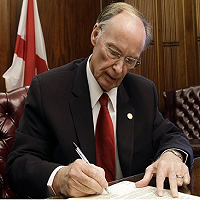31
MONTGOMERY-Governor Robert Bentley has proclaimed the week of November 14 through 18 as “Rural Health Week” in Alabama. This recognition is to increase Alabamians awareness of the vital importance of our rural areas and the serious struggle that these areas have in getting and keeping adequate health care.
Many people make the mistake of thinking that since our rural areas have smaller populations, they are not as important as more urban areas with larger numbers of people. This is far from the truth. Rural areas are the providers of the vast majority of materials, resources, and necessities, such as food, that everyone must have in order to survive. Having healthy and vibrant rural areas is important to everyone.

There is a very strong relationship between having adequate health care and economic opportunity. An area without adequate health care is not very competitive with other areas in attracting economic opportunity and growth. Too many young residents of rural areas are being forced to go elsewhere to develop careers following college or technical training.
Perhaps the greatest evidence of the lack of economic opportunity and healthy growth is the fact that 24 rural Alabama counties have smaller populations today than they had over 100 years ago in 1910. In addition, 41 Alabama counties, 39 rural and two urban, are projected to have less population in 2040 than they had in 2010. Alabama’s population growth is projected to be the lowest among all southern states, less than one half of Mississippi’s growth.
Rural health care does not only provide service for rural residents. Often we or someone that we care very much for will be in a rural area and suddenly be in need of health care. The presence of adequate local health care throughout Alabama provides faster access to care that can be of vital importance to survival.
Additional indicators of the serious need for adequate rural health care include the following:
Alabama has the 3rd highest death rate among all 50 states and the rate is 10 percent higher for our rural residents than urban Alabamians.
Life expectancy is three years less for Alabamians than for the nation – 3 ½ years less for rural Alabamians and as much as nine years less in specific rural counties.
In 1980, 45 of the 54 rural counties in Alabama had hospitals that provided obstetrical service. Today only 16 of these 54 counties still have such service available. The loss of hospitals that deliver babies is greater in the 12 counties comprising the Black Belt Region. In 1980, 10 of these 12 counties had hospitals providing obstetrical service. Today only one county (Dallas) still has this service available.
Only two rural counties (Coffee and Pike) are recognized by the Health Resources and Services Administration as providing the minimal primary care service that is needed.
None of the 54 rural counties provide minimal dental service that is needed for low-income (Medicaid) patients.
None of the 54 rural counties provide minimal mental health service.
Thirteen rural Alabama counties do not have a dialysis clinic in the county.
The motor vehicle accident death rate for rural Alabamians is nearly 67 percent higher than that for our urban residents and more than 120 percent higher than the national rate.
Alabama is economically dependent upon its rural areas and our rural areas must have adequate health care to meet this need. During this special week of recognition for rural health, express your support for measures and policies that can strengthen rural health care in Alabama. For additional information, please visit the Alabama Rural Health Association’s website at www.arhaonline.org.
Media Release/Alabama Rural Health Association/ Dale Quinney



